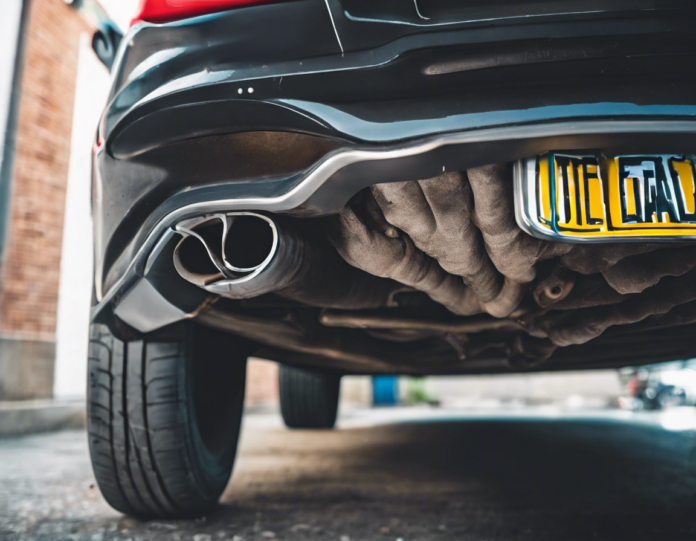Exhaust leaks are a common issue that many vehicle owners face. Not only can they be annoying due to the loud noise they produce, but they can also be dangerous as they can release harmful gases into the cabin of the vehicle. Luckily, fixing an exhaust leak is a task that can often be done at home with a few tools and some basic mechanical knowledge. In this guide, we will walk you through the steps to fixing an exhaust leak on your own.
Identifying the Leak
The first step in fixing an exhaust leak is to identify the source of the leak. Common areas where leaks occur include the exhaust manifold, exhaust pipe, exhaust flange, and muffler. You can identify the leak by looking for black soot around the area where the leak is occurring or by listening for a loud hissing noise when the engine is running.
Tools Required
Before you begin fixing the exhaust leak, make sure you have the following tools on hand:
– Jack and jack stands
– Safety glasses and gloves
– Pry bar
– Wire brush
– Sandpaper
– Exhaust repair kit
– High-temperature exhaust sealant
Steps to Fixing an Exhaust Leak
- Safety First: Park your vehicle on a level surface and engage the parking brake for safety.
- Locate the Leak: Use a flashlight to locate the source of the leak.
- Raise the Vehicle: Lift the vehicle using a jack and secure it with jack stands.
- Inspect the Exhaust System: Check the exhaust system for any cracks, holes, or rusted areas.
- Clean the Area: Use a wire brush and sandpaper to clean the area around the leak.
- Apply the Exhaust Repair Tape: Wrap the exhaust repair tape around the leak tightly, following the manufacturer’s instructions.
- Apply the Exhaust Sealant: Apply a layer of high-temperature exhaust sealant over the repair tape to ensure a tight seal.
- Lower the Vehicle: Carefully lower the vehicle back to the ground.
- Start the Engine: Start the engine and listen for any signs of leakage. If the leak persists, repeat the above steps or consult a professional mechanic.
Preventative Maintenance
To prevent future exhaust leaks, consider the following tips:
– Regularly inspect your exhaust system for any signs of damage or rust.
– Maintain your vehicle according to the manufacturer’s recommendations.
– Avoid driving over rough terrain or hitting speed bumps too quickly.
Frequently Asked Questions (FAQs) about Fixing Exhaust Leaks:
Q: Can I drive my car with an exhaust leak?
A: It’s not recommended to drive your car with an exhaust leak as it can lead to harmful gases entering the cabin and can also affect your vehicle’s performance.
Q: How much does it cost to fix an exhaust leak?
A: The cost of fixing an exhaust leak can vary depending on the extent of the damage and the type of repairs needed. It can range from a DIY repair costing around $50 to $200+ for professional repairs.
Q: How long does it take to fix an exhaust leak?
A: Fixing an exhaust leak can take anywhere from 1-3 hours depending on the severity of the leak and your level of experience with automotive repairs.
Q: Can I use duct tape to fix an exhaust leak?
A: While duct tape can be used as a temporary solution for small exhaust leaks, it is not recommended for a permanent fix. It’s best to use an exhaust repair kit for a more lasting repair.
Q: What are the dangers of driving with an exhaust leak?
A: Driving with an exhaust leak can expose you to harmful gases like carbon monoxide, impact your vehicle’s fuel efficiency, and lead to potential engine damage.
Q: How often should I check my exhaust system for leaks?
A: It’s a good practice to check your exhaust system for leaks as part of your regular vehicle maintenance routine, ideally every few months or whenever you hear unusual noises coming from your vehicle.
Q: Can I fix an exhaust leak myself?
A: Fixing an exhaust leak is a task that can often be done at home with the right tools and some basic mechanical knowledge. However, if you are unsure or uncomfortable with the process, it’s best to consult a professional mechanic.
Q: What are the signs of an exhaust leak?
A: Signs of an exhaust leak include loud hissing noises coming from the exhaust system, decreased fuel efficiency, a strong smell of exhaust fumes inside the vehicle, and visible soot around the exhaust system.
Q: How do I know if my exhaust leak is serious?
A: If you notice any of the signs mentioned above, it’s best to address the exhaust leak promptly to avoid any potential dangers or further damage to your vehicle.
Q: Can I fix an exhaust leak without lifting the vehicle?
A: While it’s possible to fix some exhaust leaks without lifting the vehicle, it’s generally easier and safer to do so, as it allows for better access to the exhaust system.
In conclusion, fixing an exhaust leak is a manageable task that can be done with the right tools and knowledge. By following the steps outlined in this guide and practicing regular maintenance, you can keep your vehicle running smoothly and safely. If you encounter any difficulties or are unsure about the repair process, don’t hesitate to seek help from a professional mechanic.









